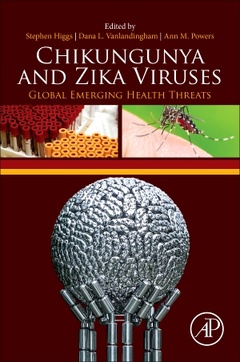Chikungunya and Zika Viruses Global Emerging Health Threats
Coordonnateurs : Higgs Stephen, Vanlandingham Dana L., Powers Ann

Chikungunya and Zika Viruses: Global Emerging Health Threats is the go-to resource for both historical and current information on this important virus that is rapidly increasing its global range. Epidemics since 2005 have spread from Africa and Asia, and through Europe, and an ongoing epidemic has caused nearly two million cases in the Americas. It causes severe crippling arthritis, with symptoms lasting for months or years. As no vaccine or treatment is available, there is international interest in the virus, thus funding opportunities for research have dramatically increased. This book presents our understanding of the virus, bringing comprehensive knowledge in a single source.
1. History of Chikungunya 2. Transmission Cycle 3. Human Diseases 4. Chikv in Africa 5. Chikv in Asia 6. Chikv in Europe 7. Chikv in Americas 8. Chikv Genetics 9. Diagnostics and Laboratory Techniques 10. Animal Models 11. Vaccine Candidates 12. The Future
academics, including Virologist, Immunologists, Epidemiologists, Geneticists, Vaccinologists. Furthermore, the pharmaceutical industry would be interested in this book. Also, policy makers and centers for disease control would be interested
Dr. Vanlandingham’s research is focused on the interactions between arboviruses, the mosquito vectors, and the vertebrate host. Infectious clone technology is used to identify the molecular determinants of infection of alphaviruses, bunyaviruses, and flaviviruses. There are currently four areas of research in her laboratory: 1) Rift Valley fever virus vaccine development; 2) examining vector competence of North American mosquitoes for Japanese encephalitis virus; 3) rationale vaccine design based on characterizing yellow fever virus to identify molecular determinants of infectivity and transmissibility by Ae. aegypti mosquitoes; and 4) assessing CHIKV-mosquito interactions and virus inactivation procedures to ensure blood transfusion safety.
Dana obtained her B.S. and M.S. degrees from Colorado State University and her Ph.D from the Liverpool School of Tropical Medicine in 2006.
- Provides a comprehensive collection of the state-of-the-art on CHIKV biology in a go-to reference book
- Edited by leaders in the field who provide a single, up-to-date source of information
- Gives a better understanding of the transmission and spread of chikungunya virus, a clear, coherent description of the outcomes of infection (both acute and chronic), and its biology and risk factors
- Pulls relevant background information to justify projects of many professionals developing vaccines and mosquito vector control approaches
Date de parution : 06-2018
Ouvrage de 398 p.
15x22.8 cm
Thèmes de Chikungunya and Zika Viruses :
Mots-clés :
Aedes aegypti; Aedes albopictus; Africa; Alphavirus; Animal model; Animal models; Arboviral; Arbovirus; Arboviruses; Asia; Chikungunya; Chikungunya virus; Clinical features; Clinical trials; Congenital Zika syndrome; Dengue-like illness; Discovery; Diseases; Ecology; Emergence; Epidemiology; Europe; Febrile exanthem; Flavivirus; Guillain-Barre syndrome; IgG; IgM; Immunity; Interventions; Laboratory diagnosis; Mosquito; Mosquitoes; Outbreaks; Pathology; Real-time RT-PCR; RNA; Serology; Sylvatic cycle; Symptoms; Togavirus; Transmission; Vaccines; Vectors; Vertebrate hosts; Viral arthritis; Virus; Zika; Zika virus



